”Why Gender? And Why Myanmar?” These are the most frequently asked questions I have encountered when people enquire what I have been up to for the last year. Also followed by ”What have these got to do with Agriculture?’’. Agriculture can be used as the pathway to tackle Myanmar’s problems related to gender inequalities, food insecurities and climate change. In fact, the three are related and better integration of three areas could help provide solutions to their related problems.
As previously mentioned in the introduction 70% of Myanmar’s agriculture workforce are female, (FAO, 2016). It is unclear as what they get paid per agriculture activity as women’s work is not valued by society therefore documentation of women pay is not deemed important. The lack of value for women labor contribution is also highlighted by the 25% gender gap in daily wages, between men and women working the same jobs. This strengthens the traditional belief and social norms expected of women, – as care givers whose place is in the home – and further discounts women’s values and potential, making it harder for women to break these restrictive barriers, (Network, 2015), (Thein, 2015), (GEN, 2016),(WOMEN, 2016),(FAO, 2016).
Myanmar, home to almost 54.5million people, is an agricultural country with 69% of the population relying directly or indirectly on agricultural production for their livelihoods, (FAO, 2016). The majority of these are small-hold farmers dependent on rain-fed agriculture and the additional natural resources the country provides. Therefore, Myanmar’s food security, nutrition and livelihoods are predicted to face increased direct and indirect climate change impacts as will be the case for the entire Southeast Asia, (IPCC, 2014). As well as women representing a large part of the agri sector they also play a vital role in food security and nutrition in the agri sector, often carry out most tasks related to crop cultivation from planting and weeding to harvesting and marketing, while also having the main responsibility for domestic and care work.
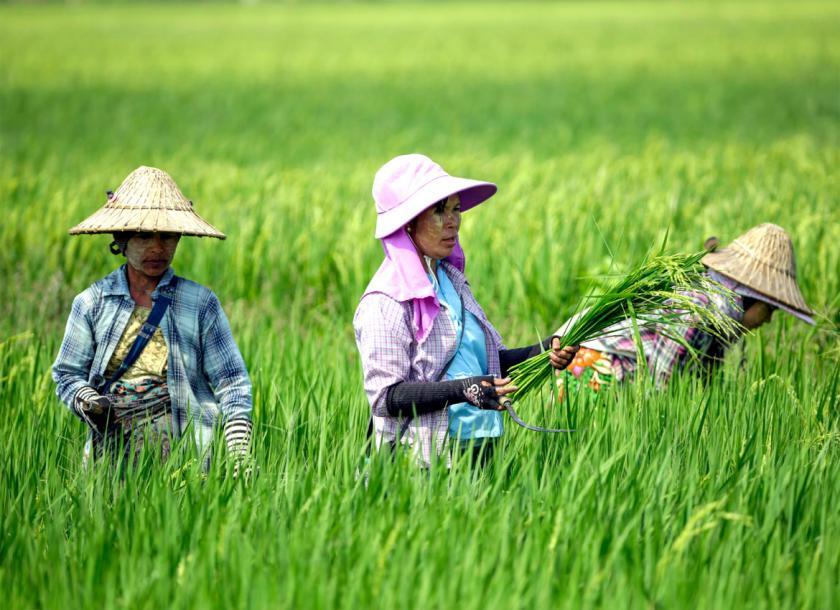
Source: The Myanmar Times.
Myanmar is currently ranked 148 of 189 countries, in the human development Index, due to their low gender inequality standards, (UNDP, 2018). As outlined Gender Equality Network report, women in Myanmar face many obstacles in pursuit to gender equality, such as different societal roles, unequal access and control of resources, lack of female participation in decision making process and thus have created gender gaps between farmers in rural communities, (GEN, 2016), (Network, 2015), (FAO, 2016), (Paris, 2019). These obstacle to gender empowerment increases women vulnerability to adapt to cc and maintain food and nutrient security at times of crises. i.e. women have limited access to land rights therefore without control or ownership of land are unable to apply for loan to buy new drought resilient seed variety.
Because decisions on climate change adaptation aiming to increase food security, depend on opportunities governed by the varied and complex interplay of social relations, institutions, organizations, and policies, it is critical that we continue to examine our understanding of inequality in agriculture (Deering, 2014; Pérez et al., 2014). Hence the use of gender lens by inclusion of this gender dimension study as part of IIRR food security project in Myanmar. While also keeping the focus of this gender study in line with various intertwined commitments and policies Myanmar has made to reduce the disparity between genders in all sectors and encourage the participation of women within community initiatives, i.e. The National Strategic Plan for the Advancement of Women (2013-2022) (NAPA), Beijing Platform for Action and The Convention on the Elimination of all Forms of Discrimination Against Women (CEDAW).
Climate change has been recognised as the biggest threat to food security and adequate nutrition in the twenty-first century (Seager et al. 2007). Agriculture has major responsibility for the current GHG emissions emitted during this anthropogenic era. Indeed the use of unsustainable farming practices such as over application of fertilizer, monocropping, deforestation for land use change, all in order to make food production more economically efficient and meet growing global food demands has resulted in environmental damage such as desertification, soil erosion, low soil fertility, water pollution. Agriculture is the dominant sector of Myanmar’s economy and contribute approx. 37.8% of GDP, (FAO, 2020). This includes agricultural process of wood, wood products; copper, tin, tungsten, iron; cement, construction materials; fertiliser; petroleum and natural gas; garments, jade and gems and well as food production for the global market. All of which involve either the depletion of natural resources or the process itself is damaging to surrounding environment.
Example of enviornmental damaging agriculture practise in Myanmar. Global rice production is responsible for at least 10% of total global agricultural GHG emissions. [The global rice production emits between 500-800 million tons of CO₂ equivalent per year]. Myanmar was the eighth largest exporter of rice in 2019 and the government of Myanmar has set ambitious targets to increase rice exports by 4million tons by 2019/2020. By meeting this target via traditional growing methods, will also potentially increase methane emissions (which is second to importance to CO2 as a greenhouse gas. The traditional flood system used for Rice production is responsible for at least 10% of anthropogenic ghg emissions in the agricultural sector globally at least 1% of global GHG emissions, (Searchinger, et al, 2015), (Yan, et al, 2009).
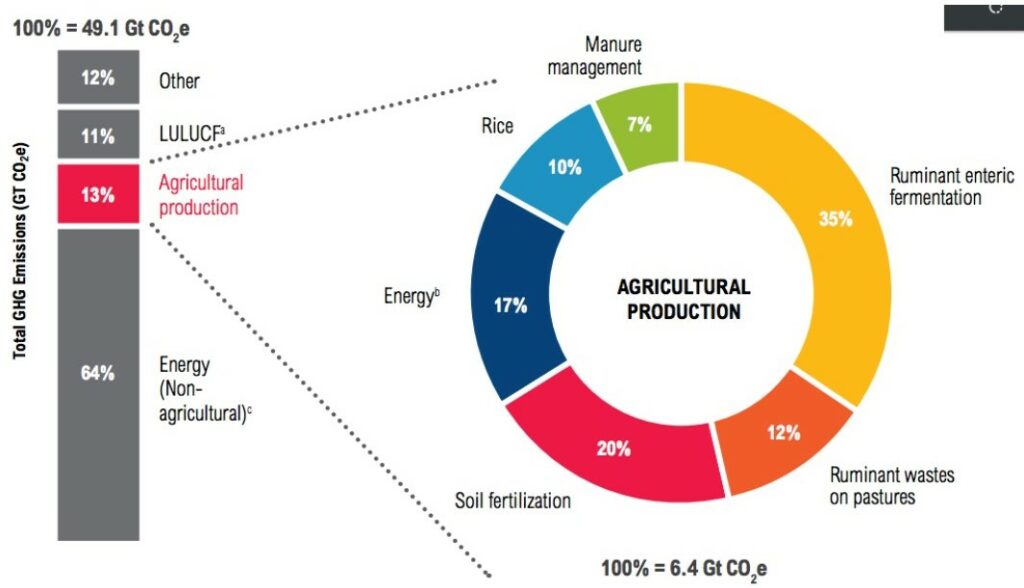
Source: World Resources Institute.
https://web.archive.org/web/20190308094241/https://www.wri.org/sites/default/files/Shifting_Diets_for_a_Sustainable_Food_Future_1.pdf
However using sustainable agri methods for rice i.e. drought/salinity tolerant rice varieties, improved irrigation/water storage, altering planting times, alternate wetting and drying, reducing slash-and-burn land preparation method etc. could reduce water consumption, prevent rise of CO2 levels, while increase yield and resilience of crop to climate change, (Wassmann et al., 2009), while continuing to support small farmers and provide a staple food crop to the world population. Myanmar’s drop in rice exports [just one area of agri production] since 2010 – 2018 [as shown in image:] is largely due to it vulnerability to weather variabilities caused by climate change and Myanmar location which is prone to extreme weather events, droughts, floods, cyclones, (Wassmann et al., 2009). This further illustrates that rice production need to change not only to reduce GHG emissions but to help maintain country’s GDP and continue meeting food demand of globale growing population.
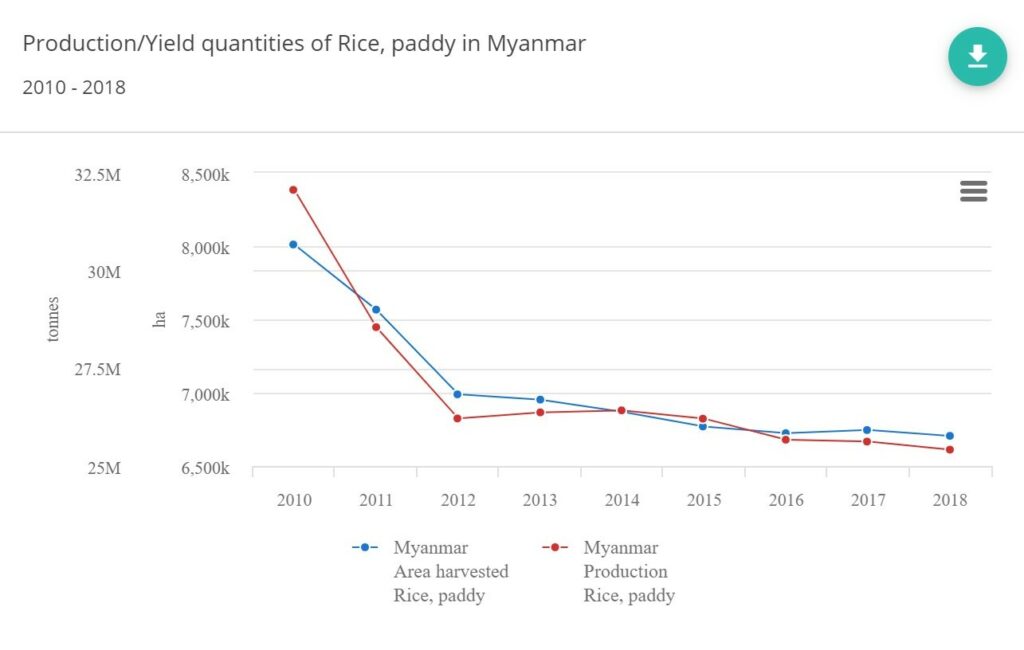
The overall aim of IIRR’s project is to understand existing gender dimensions which impact on food security in rural agricultural areas of Myanmar. The hope is to gain a greater understanding of all the intricacies involved in current food system with the long-term aim to improve food security by identifying sustainable, inclusive and efficient food systems [CSA options]. The inclusion of csa in a project meets gov framework but the added inclusion of gender supports the project long term success, as it allows adaption and full participation of CSA therefore it enables all farmers to take ownership of the CSA they chose to implement, (Villavicencio, Rosimo, Vidallo, Oro, & Gonsalves, 2018). By using CSA in rural parts of Myanmar enables its benefits reach the most vulnerable to CC without adding further pressure on planetary boundaries.
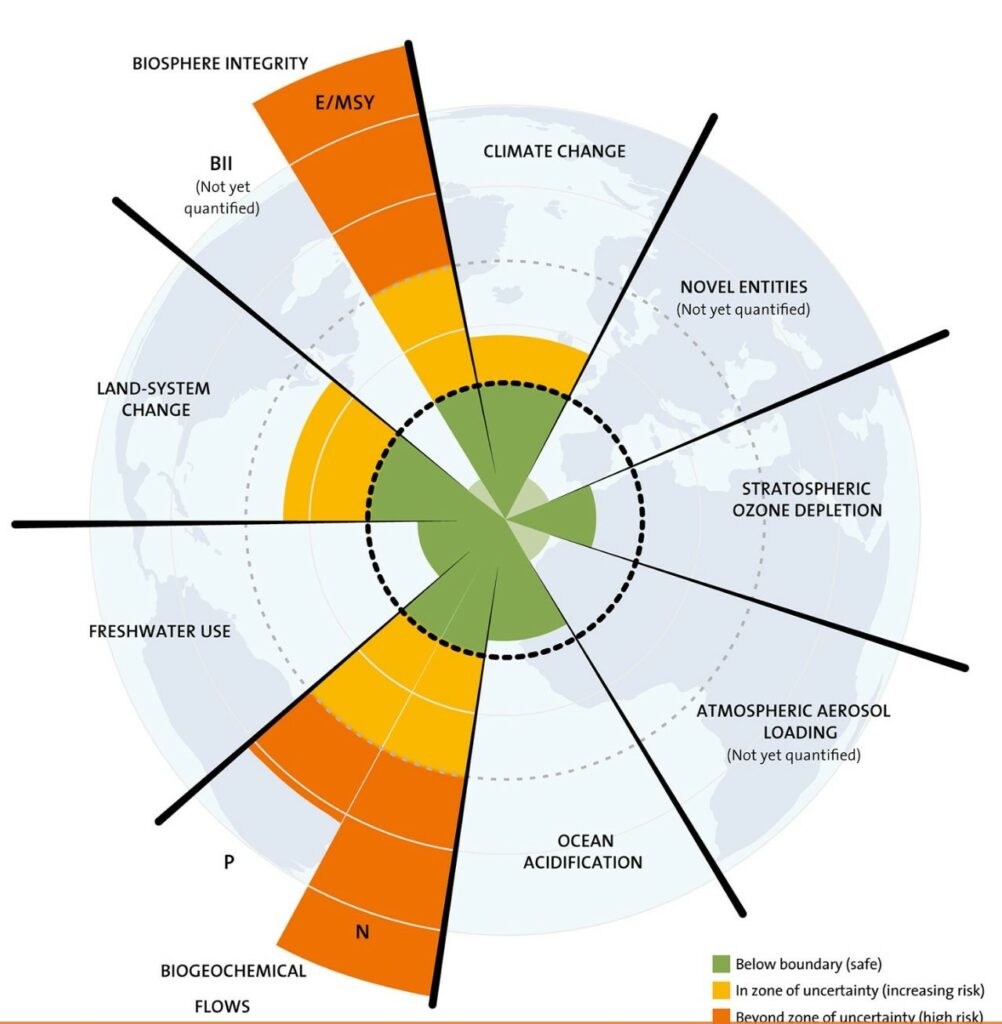
Source: https://www.stockholmresilience.org/research/planetary-boundaries.html
The project meet many criteria outlined by UN to meet the 2030 Sustainable Development Goals in Myanmar agriculture seems like the logical pathway to tackle gender inequalities, food insecurity and climate change. By using sustainable agriculture techniques i.e. (Climate Smart Approaches -CSA) in a participatory fashion i.e. (CBA) agri becomes the nexus between these three complex areas.
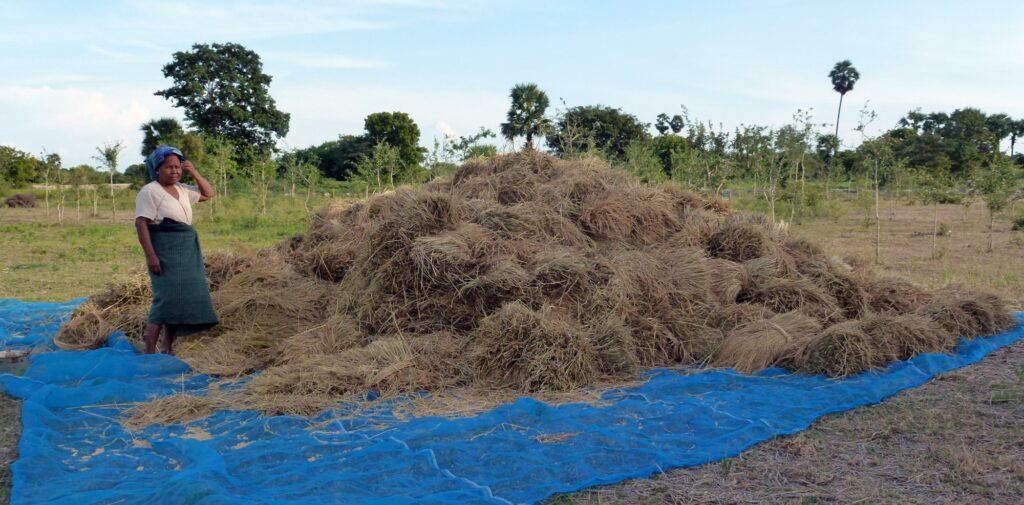
Bibliograpgy:
FAO. (2016). MYANMAR: National Action Plan for Agriculture (NAPA).
FAO. (2020). FAO in the 2020 humanitarian appeals | Myanmar. Retrieved from http://www.fao.org/3/ca7805en/CA7805EN.pdf
Deering, K. (2014). Stepping up to the challenge-Six issues facing global climate change and food security. Retrieved from https://cgspace.cgiar.org/bitstream/handle/10568/51553/Six%20issues%20facing%20global%20climate%20change%20and%20food%20security.pdf?sequence=15&isAllowed=y
GEN. (2016). Report on Obstacles to Gender Equality in Myanmar. Retrieved from file:///C:/Users/sally/Dropbox/McCarrick,%20Sally%20IIRR/PDFs%20to%20read/Obstacles%20to%20gender%20equality%20in%20Myanmar%20FullReport.pdf
Network, G. E. (2015). Raising the curtain: Cultural norms, social practices and gender equality in Myanmar. Gender Equality Network Yangon.[online] Available from: http://www. genmyanmar. org/publications/GEN% 20Raising% 20the% 20Curtain% 20Full% 20E ng. pdf [Accessed: 18/9-16].
Paris, T. R., and M.F. Rola-Rubzen (Eds.). (2019). Gender Dimension of Climate Change Research in Agriculture
Pérez, C., Jones, E., Kristjanson, P. M., Cramer, L., Thornton, P. K., Förch, W., & Barahona, C. (2014). How resilient are farming households, communities, men and women to a changing climate in Africa?
Searchinger, T., Adhya, T. K., Linquist, B., Wassmann, R., & Yan, X. (2015). Wetting and drying: reducing greenhouse gas emissions and saving water from rice production.
Thein, P. T. (2015). Gender equality and cultural norms in Myanmar. Paper presented at the INT’L CONFERENCE ON BURMA/MYANMAR STUDIES (Jul. 2015).
UNDP. (2018). Human Development Report. Retrieved from http://hdr.undp.org/en/content/table-5-gender-inequality-index-gii
Villavicencio, F., Rosimo, M., Vidallo, R., Oro, E., & Gonsalves, J. (2018). Equity, empowerment and gender relations: A literature review of special relevance for climate-smart agriculture programming.
Wassmann, R., Jagadish, S., Sumfleth, K., Pathak, H., Howell, G., Ismail, A., . . . Heuer, S. (2009). Regional vulnerability of climate change impacts on Asian rice production and scope for adaptation. Advances in agronomy, 102, 91-133.
WOMEN, U. (2016). Gender Equality and Women’s Rights in Myanmar: A Situation Analysis.
Yan, X., Akiyama, H., Yagi, K., & Akimoto, H. (2009). Global estimations of the inventory and mitigation potential of methane emissions from rice cultivation conducted using the 2006 Intergovernmental Panel on Climate Change Guidelines. Global biogeochemical cycles, 23(2).